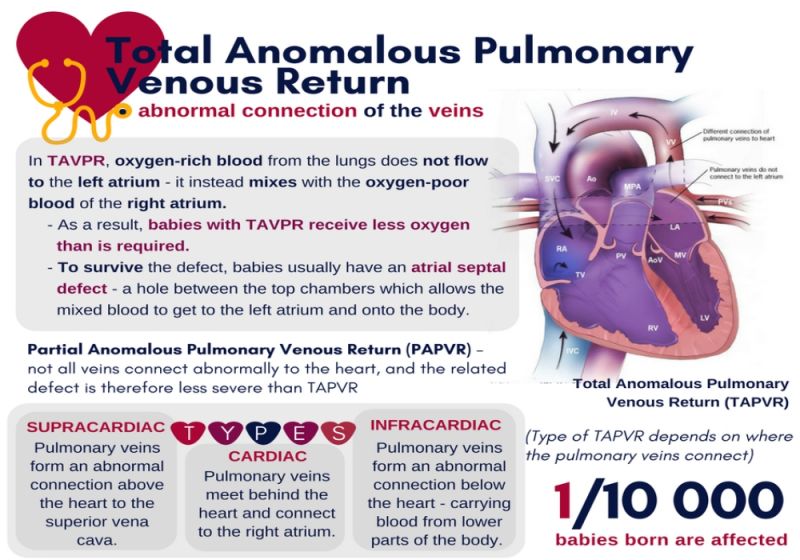Total Anomalous Pulmonary Venous Return (TAPVR)
What generally happens is, you have a beautiful little baby, they're born, and then they turn completely blue - Sarah Badran MD

image by: Maboneng Heart and Lung Institute
HWN Recommends
Conquering CHD: Sydney Kim
Sydney was born with total anomalous pulmonary venous return (TAPVR) with an atrial septal defect (ASD) and patent ductus arteriosus (PDA).We so desperately wanted to believe that surgery had cured her, but the reality is that no one is ever truly cured from congenital heart disease (CHD)... Since her second open-heart surgery, Sydney has undergone multiple cardiac catheterizations and had a stent placed in her pulmonary vein. We stopped keeping track of how many ECHOs, EKGs, and lung perfusion scans she’s undergone a long time ago. It’s part of her life and will always be her “normal.” Sydney will have a lifelong battle with CHD, but she is thriving. She is becoming more aware and self-conscious…
Resources
A Pair of Daring Heart Procedures Save Preemie Alex’s Life
In normal circulation, the lungs load the blood with oxygen and send it through the pulmonary veins to the heart’s left atrium, and then out to the body’s organs through the aorta. Then depleted of oxygen, the blood returns to the right side of the heart before getting pumped back into the lungs, and the whole circuit repeats. Before birth, this exchange is formed anatomically, as the pulmonary veins become anchored to the back of the left side of the heart. In rare instances—1 in 10,000 births—that attachment doesn’t develop. The pulmonary veins “just get lost,” Dr. Badran says, draining the blood out elsewhere within the body and leaving it without any road back to the heart, a birth defect called total anomalous pulmonary venous return (TAPVR).
My “Why.”
While Eli super-star-soared into graduation from the NICU where I worked, Virgil needed to be transferred to a hospital where they were able to repair his heart.
Scimitar Syndrome
The scimitar syndrome is a complex malformation of the heart, lungs, and blood vessels. The main feature of this malformation is the anomalous drainage of the pulmonary veins into the inferior vena cava. Scimitar syndrome represents a combination of pulmonary hypoplasia and partial anomalous pulmonary venous return (PAPVR) which can be noted on CXR and can be documented angiographically.
Snowman sign
The “snowman sign” is a particular image on a chest X-Ray image, which is seen in anomalous pulmonary venous drainage and coarctation of the aorta which causes a Total Anomalous Pulmonary Venous Return (TAPVR).
Total Anomalous Pulmonary Venous Connections: Anatomy and Diagnostic Imaging
TAPVR anatomy and subtypes...
Total Anomalous Pulmonary Venous Return (TAPVR)
In an anatomically normal heart, the pulmonary veins connect to the left side of the heart and provide oxygen-rich blood to the body. In TAPVR, the pulmonary veins connect….well, not there.
 Conquering CHD: Sydney Kim
Conquering CHD: Sydney Kim
These terms were completely foreign to us and the thought of our baby undergoing, let alone surviving, open-heart surgery was beyond comprehension.
CHOP
Children with TAPVR also have other heart defects. They have a hole in the wall separating the two upper chambers of the heart (atrial septal defect) and may have a patent ductus arteriosus, an extra blood vessel between the pulmonary arteries and the aorta.
Nationwide Childrens'
In this condition, the 4 blood vessels (pulmonary veins) that carry oxygen-rich (red) blood to the heart from the lungs aren’t connected correctly. Normally these blood vessels should be connected to left upper chamber (atrium) of the heart. Instead, they’re connected somewhere else.
Tiny Tickers
TAPVC is most commonly detected after birth by echocardiogram.

Introducing Stitches!
Your Path to Meaningful Connections in the World of Health and Medicine
Connect, Collaborate, and Engage!
Coming Soon - Stitches, the innovative chat app from the creators of HWN. Join meaningful conversations on health and medical topics. Share text, images, and videos seamlessly. Connect directly within HWN's topic pages and articles.













